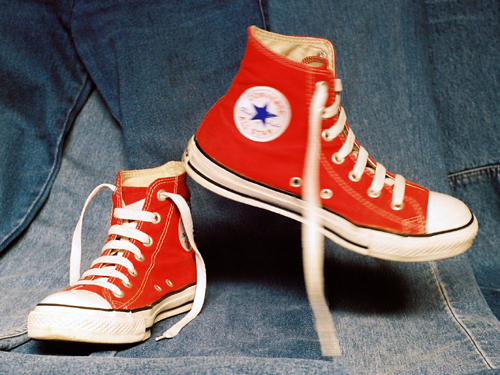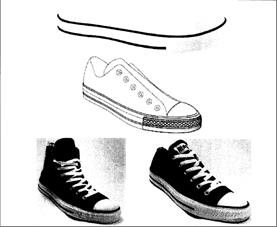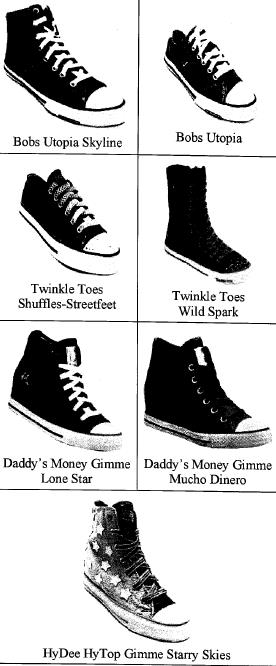Trademark Infringement: Can Converse Sue Others For Making Look-alike Sneakers based on a "Shape Mark"?
Background
On 14 October 2014, Converse Inc. (“Converse”), a well-known footwear producer in the US, filed lawsuits in the United States District Court in Brooklyn (the “Complaints”) against more than 30 companies (the “Companies”) including Ralph Lauren Corporation, Skechers U.S.A., Inc., and Kmart Corporation, for infringing Converse’s shape mark registration which protects the certain shape and features in the design of its iconic sneaker.

Converse also filed separate complaints against the Companies under s. 1337 of Title 19 of the U.S. Code – unfair practices in import trade at the United States International Trade Commission, which is empowered to stop counterfeit goods from entering the United States.
There were multiple allegations made by Converse, including: (i) trademark infringement; (ii) false designation of origin; (iii) unfair competition; (iv) trademark dilution; and (v) unfair business practices. This article will focus on exploring the potential claim of trademark infringement.
In the Complaints, Converse alleged that it owns rights in the shape of the midsole design adopted in their sneakers which is registered as a trade mark in the United States (the “Subject Mark”). The Subject Mark was registered in Class 25 (footwear). The registration of the Subject Mark specified that protection is conferred on the design of the two stripes on the midsole of the shoe, the design of the toe cap, the design of the multi-layered toe bumper featuring diamonds and line patterns, and the relative position of these elements to each other. The following images were highlighted by Converse in the Complaint filed against Skechers U.S.A. Inc. to illustrate the shape or design of the Subject Mark (left) and the shape and design of Skechers’ sneakers (right):


Trademark infringement: Converse’s claim
Converse suggested that the Companies sold, offered to sell, distributed, promoted and/or advertised footwear products bearing shapes which are confusingly similar imitations of the Subject Mark which are likely to cause consumer confusion with and dilution of the Subject Mark which it asserts to be well-known.
Converse claimed that the Companies were in contravention of ss.32(1), 43(a) and 43(c) of the Trademark Act of 1946, namely, the Companies used the Subject Mark and/or colourable imitation of the Subject Mark without the consent of Converse, leading to consumer confusion as to the origin, sponsorship, or approval of the Companies’ shoe products, which would constitute trademark infringement.
Trademark infringement: Hong Kong’s approach
In Hong Kong, an unauthorized use of any mark similar or identical to a registered trade mark in the course of trade or business on identical or similar goods or services registered under the registered mark, and which causes confusion to the consumers, constitutes trade infringement (s.18 of the Trade Mark Ordinance (Cap. 559) (“TMO”)). A trade mark may consist of words (including personal names), indications, designs, letters, characters, numerals, figurative elements, colours, sounds, smells, the shape ofgoods or their packaging and any combination of such signs.
S.18(5) of TMO clarifies the meaning of “use” by providing that a person uses a sign if he or she:
1. applies it to goods or their packaging;
2. offers or exposes goods for sale under the sign;
3. puts goods on the market under the sign;
4. stocks goods under the sign for the purpose of offering or exposing them for sale or of putting them on the market;
5. offers or supplies services under the sign;
6. imports or exports goods under the sign; or
7. uses the sign on business papers or in advertising.
Having considered the elements of trademark infringement in Hong Kong, next question is whether a mark consisting of the shape of a sneaker will be protected, in particular, as a shape mark.
shape marks in Hong Kong
Converse’s trademarks are registered in the name of All Star C.V. in Hong Kong and it appears that there is no equivalent registration of the Subject Mark in Hong Kong.
Under Hong Kong laws, three-dimensional marks or shapes are registrable if they are capable of distinguishing the goods and services of one trader from another. To seek protection of a three-dimensional shapes mark, the following requirements need to be fulfilled.
Shape functioning as a trademark
The function of a trademark is to show the connection in the course of trade between the goods (e.g. footwear) and the proprietor (e.g. Converse). Shapes that are merely pictorial descriptions of products are unlikely to function as trademarks in Hong Kong. The shape of an article cannot be registered in respect of goods of that shape, unless it contains some addition to the shape of the article which has trade mark significance.
Shapes which are not debarred from registration
However, certain shapes are debarred from registration, namely:-
1. shape resulting from the nature of the goods themselves;
2. shape of goods that is necessary to obtain a technical result;
3. shape which gives substantial value to the goods;
4. shape lacking in distinctive character; and
5. indistinctive shape with distinctive element(s) which are not immediately apparent.
In other words, elements of distinctiveness must be proven by a shape mark owner, i.e. that the public recognises the shape to be associated with the owner, and that it is confused to believe that the alleged infringer’s products is related to those of the mark owner’s, before a finding of infringement would be made. These are likely hurdles that Converse needs to overcome before succeeding in its claims in the US.
Conclusion
Whilst awaiting the outcome of these cases, it is worthwhile to be aware of possible shape mark infringement in order to protect proprietors’ right. The footwear industry should always pay much attention and caution to conduct due diligence before designing their products to avoid infringement of third parties’ rights in shape marks.
For enquiries, please contact our Intellectual Property & Technology Department:
E: ip@onc.hk
T: (852) 2810 1212
W: www.onc.hk
F: (852) 2804 6311
19th Floor, Three Exchange Square, 8 Connaught Place, Central, Hong Kong
Important: The law and procedure on this subject are very specialised and complicated. This article is just a very general outline for reference and cannot be relied upon as legal advice in any individual case. If any advice or assistance is needed, please contact our solicitors.








